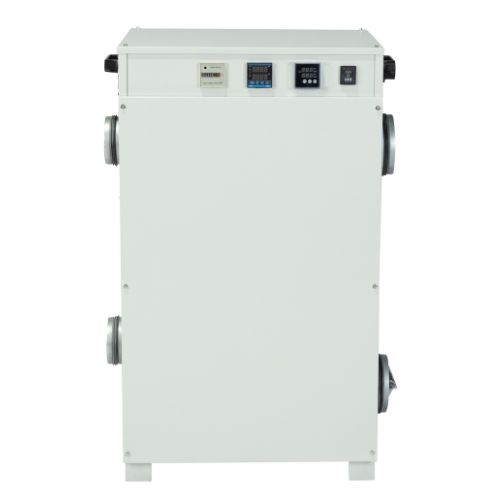

Desiccant dehumidifiers are an absorption type dehumidifier that use a desiccant rotor wheel to absorb moisture from the air.
They perform at a flat extraction rate within a wide temperature range, while refrigerant types do well at temperatures >15ºC. Therefore, in Singapore’s warm and humid climate, the use cases for desiccant dehumidifers are lower.
Generally, for low temperatures <15ºC, and extreme RH requirements down to 1% RH, we would recommend a desiccant dehumidifer. For other higher temperatures, refrigerant dehumidifiers perform better and are generally more cost effective.
However, they consume substantially more energy kW versus the refrigerant type due to the heating element, and generates heat that needs to be managed and factored into the room parameters.
Desiccant dehumidifiers are generally quieter than refrigerant types, since they don’t use a compressor.
Lastly, desiccant dehumidifiers require ducting to vent the regenerated air (moist air) out of the room – either thrown outdoors, or into a big open area that won’t be impacted by the incoming moist air. Or if the unit is placed outdoors, ducting is needed for the process air to be extracted and returned back into the space. In comparison, refrigerant types just need a drain/bucket to discharge the condensate.
| Model | DT-320RD | DT-600RD | DT-800RD |
| Humidity Removal (20 °C / 60% RH) |
2.0 kg/hr | 3.0 kg/hr | 6.0 kg/hr |
| Power Source | 220-240V / 50 Hz | 220-240V / 50 Hz | 380-415V / 50 Hz |
| Rated Power Input | 2.0 kW | 4.5 kW | 10 kW |
| Operating Temperature | -10°C – 55°C | -10°C – 55°C | -10°C – 55°C |
| Weight | 35 kg | 70 kg | 135 kg |
| Processing Air Flow | 320 m3/h | 580 m3/h | 850 m3/h |
| Regeneration Air Flow | 110 m3/h | 200 m3/h | 260 m3/h |
| Dimensions (Width x Depth x Height) |
600 x 425 x 400 mm | 585 x 420 x 866 mm | 878 x 640 x 1232 mm |
